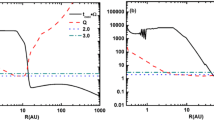Summary
From the extensive set of numerical calculations briefly described above, it seems apparent that rotating, isothermal gas clouds are unstable to fragmentation under a wide range of conditions. (Caution: This result for isothermal clouds cannot be generalized to all clouds, as is shown, for example, by Boss's analysis [these proceedings] of the stability of collapsing, adiabatic clouds.) It is of importance to note, however, that no fragmentation is apparent during a cloud's initial dynamic collapse toward a disk structure; rather it is the rotationally flattened disk/ring configuration that undergoes fragmentation. This is a considerably different picture of fragmentation than has been presented, for example, by Hoyle (1953).
The degree of instability and the mode (ring vs. blob) of fragmentation is sensitive to α, but insensitive to β. The initial amplitude of a perturbation does not appear to be crucial--fragmentation should occur eventually even for low amplitude initial NAPs.
Finally, it is of some interest to know what the properties are of the fragments that break out of these isothermal clouds. Before outlining these properties we emphasize that in this set of calculations we have specifically excited the m = 2 (binary) non-axisymmetric mode; hence we have in some sense suppressed the development of other modes and we have promoted the development of equal mass components in the binary systems. In these evolutions, a typical fragment contained ∼ 15% of the initial cloud mass; had a specific angular momentum ≅ 25–30% that of the original cloud; had a ratio of spin angular momentum to orbital angular momentum ≅ 0.2; and itself had a ratio of thermal to gravitational energy αfrag < 0.1. The formation of a binary system has therefore resulted in a conversion of some of the original cloud's spin angular momentum into orbital angular momentum, and has produced “protostars” with reduced specific angular momenta. It is also evident that each fragment is unstable to further collapse (having low α) under the isothermal assumptions imposed here.
Similar content being viewed by others
References
Black, D. C., and Bodenheimer, P.: 1976, Astrophys. J. 206, p. 138.
Bodenheimer, P., Tohline J. E., and Black, D. C.: 1980, Astrophys. J. Nov. 15 issue, in press.
Gerola, H. and Glassgold, A. E.: 1978, Astrophys. J. Suppl. 37, p. 1.
Hoyle, F.: 1953, Astrophys. J. 118, p. 513.
Ostriker, J. P.: 1964, Astrophys. J. 140, p. 1067.
Silk, J.: 1977, Astrophys. J. 211, p. 638.
Tohline, J. E.: 1980, Astrophys. J. 235, p. 866.
Author information
Authors and Affiliations
Rights and permissions
About this article
Cite this article
Bodenheimer, P., Tohline, J.E. & Black, D.C. Fragmentation in rotating isothermal protostellar clouds. Space Sci Rev 27, 247–253 (1980). https://doi.org/10.1007/BF00168305
Issue Date:
DOI: https://doi.org/10.1007/BF00168305




